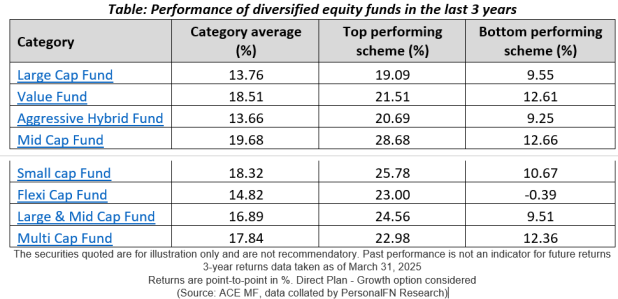The Mutual Funds Sahi Hai (Mutual Funds are a right choice) campaign, an initiative from AMFI to provide information on mutual funds investment and mutual funds basics has encouraged many investors to begin their investment journey, enabling them to mobilise their savings into wealth-creating assets. Mutual funds are now a primary choice for many first-time and experienced investors. This is reflected in the steadily rising AUM and folios of the industry over the past few years.
Here is why investing in Mutual Funds can be a right choice:
- Mutual funds are managed by experienced professionals, known as fund managers, who utilise various research and analytical tools to create an optimal portfolio.
- SEBI has set stringent regulations for asset management companies, putting investors’ interest at the fore.
- Historically, mutual funds, particularly equity-oriented funds, have outperformed conventional investment options such as bank fixed deposits and gold over the long term. This makes them suitable for long-term wealth creation and for achieving various financial goals.
- Mutual funds enjoy high liquidity, allowing investors to buy or sell units any time as per their preference.
- Mutual funds invest in an array of securities to minimise the concentration risk towards a single stock/theme/sector. Thus, investors benefit from diversification thereby lowering the overall risk.
- Investors in mutual funds may also enjoy tax advantage as investments in certain sub-categories such as ELSS are eligible for deduction under Section 80C of the Income Tax Act.
But along with the benefits, there are several risks too. Hence, not all mutual fund schemes are sahi for you.
Apart from the inherent risk of investing in mutual funds such as market risk, liquidity risk, credit risk, macroeconomic risk etc., there is also the risk of not choosing the right mutual fund schemes as per your financial objectives. The degree of aforementioned risk varies from category to category and even at the scheme level. This makes it vital to choose the right scheme.
Investors often assume that investing in a certain top-performing scheme/s may be the right fit for the portfolio. But the fact is no two mutual fund schemes are identical. A mutual fund scheme may not be right for you if the investment objective and the risk profile of the scheme do not align with your personal financial goals and risk tolerance.
Unlike Bank FD, PPF, and gold, mutual funds are not a ‘one size fits all’ investment product. One has the option to choose from different asset classes mainly equity, debt, and gold. These asset classes comprise various sub-categories (for example large cap, mid cap, small cap, multi cap, etc. in case of equity mutual funds), as well as different investment styles (value, growth, blend). This highlights that schemes across categories and sub-categories can differ significantly from one another in terms of their investment philosophy, objective, and strategy.
To put it simply, equity mutual funds are suitable for high-risk investors with long-term goals. Within equity mutual funds, Large Cap Funds, Value Funds, and Hybrid Funds are suitable for those looking for steady growth of capital over the long run with relatively lower volatility.
On the other hand, Mid Cap Funds and Small Cap Funds are suitable for investors aiming for high returns, albeit at a relatively higher risk.
Meanwhile, Flexi Cap Funds, Large & Mid Cap Funds, and Multi Cap Funds are suitable for those aiming to benefit from a mix of growth and stability as these funds invest in a blend of stocks across the large-cap, mid-cap, and small-cap segments.

Investors should ideally avoid Sector & Thematic Funds as they are high-risk high-return investments, making them unsuitable for most investors. These are suitable for investors who are familiar with the risk associated with such investments and are willing to take tactical allocations in them.
It is essential to take a closer look at the investment allocation and strategy adopted by the mutual fund house and the respective schemes before you invest in them.
For conservative investors, opting for debt-oriented mutual funds such as Liquid Funds or other short-term funds may prove worthwhile as these schemes are less prone to market fluctuations.
Choosing the appropriate mutual fund category is just the first step. You need to periodically analyse the performance of schemes within the portfolio as well.
Do note that even under the same category, mutual fund schemes can vary widely in performance. The underlying cause of this effect lies in the investment objective of the scheme, the investment process, risk management, and fund manager’s skill level. Thus, when it comes to selecting the right mutual fund scheme, you need to look much deeper.
Conclusion
Mutual Funds are sahi, but when making investment decisions, you need to have a sound plan in place. This will help you focus on the broader picture—the reasons why you are investing in mutual funds in the first place and the suitable approach to follow to achieve these goals. Thus, depending on your investment objectives, time horizon, and risk profile, it is imperative to chalk out a plan with optimal asset allocation, carefully balancing risks and rewards.
Mutual Fund Investments are subject to marker risks. Read all the related documents carefully before investing.
This article first appeared on PersonalFN here.
Disclaimer: The website managers, its employee(s), and contributors/writers/authors of articles have or may have an outstanding buy or sell position or holding in the securities, options on securities or other related investments of issuers and/or companies discussed therein. The content of the articles and the interpretation of data are solely the personal views of the contributors/ writers/authors. Investors must make their own investment decisions based on their specific objectives, resources and only after consulting such independent advisors as may be necessary.



